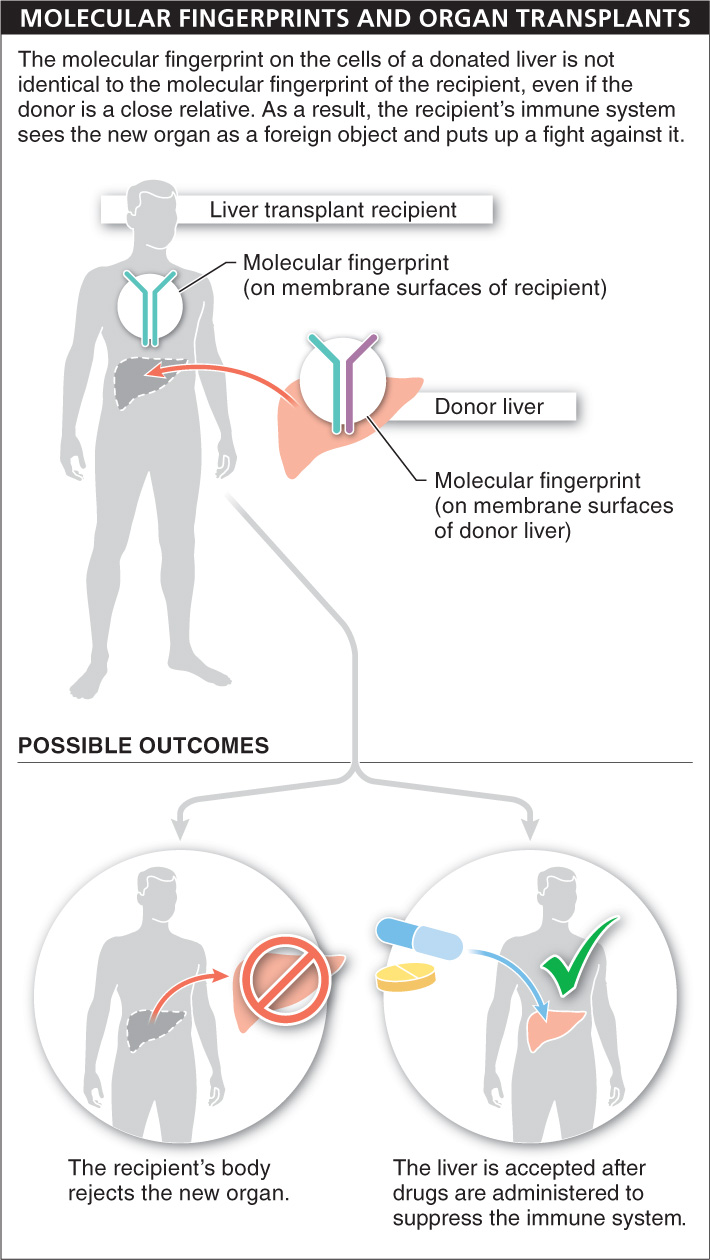Every cell in your body has a “fingerprint” made from a variety of molecules on the outside-
Throughout our evolutionary history, this system has been tremendously valuable in helping our bodies fight infection. In some cases, however, this vigilance is a problem, like a car alarm that goes off even when you don’t want it to. Suppose you receive a liver (or any other organ) transplant. Even if the donor is a close relative, the molecular fingerprint on the cells of the donated liver is not identical to your own. Consequently, your body sees the new organ as a foreign object and puts up a fight against it (FIGURE 3-15). Because your body will naturally try to reject the new organ, doctors must administer drugs that suppress your immune system. Immune suppression helps you tolerate the new liver, but, as you can imagine, it leaves you without some of the defenses to fight off other foreign invaders, such as bacteria that may cause infection.

Why is it extremely unlikely that a person will catch HIV from casual contact—
The AIDS-
One CD marker, called the CD4 marker, is found only on cells deep within the body and in the bloodstream, such as immune system cells and some nerve cells. It is the CD4 marker, in conjunction with another receptor, that is targeted by HIV. If the virus can find a cell with a CD4 marker, it can infect that cell, and because the CD4 markers never occur on the surface of skin cells, casual contact such as touching is very unlikely to transmit the virus (FIGURE 3-16). Even if millions of HIV particles are present on a person’s hands, they just can’t gain access into any of the other person’s surface cells.

101
The most common ways, by far, of transmitting HIV involve the transfer of blood, semen, vaginal fluid, or breast milk from one individual to another. Particles of the virus as well as cells infected by the virus are present in these fluids. Consequently, the chief routes of transmission are from an infected mother to her child in breast milk, from an infected mother to her baby at birth, the use of contaminated needles, and unprotected sexual intercourse. Because an open sore or cut might expose some of the cells in your bloodstream to the outside world, however, it is not impossible for casual transmission of HIV to occur.
TAKE-HOME MESSAGE 3.7
Every cell in your body has a “fingerprint” made from a variety of molecules on the outside-
What are “molecular fingerprints”? Why do they explain the fact that one cannot catch HIV through casual contact?
“Molecular fingerprints” are molecules on the outside-facing surface of the cell membrane of every cell in your body. The molecular fingerprints common to all cells signal to the immune system that the cells “belong.” Any cells with an unrecognized fingerprint are considered foreign and are attacked.
The HIV virus uses molecular fingerprints on plasma membranes to infect an individual’s cells. But because the particular molecular fingerprints that HIV interacts with (called CD markers) occur only in cells deep within the body and in the bloodstream, it is virtually impossible for casual contact, such as shaking hands or touching, to lead to HIV infection.
102